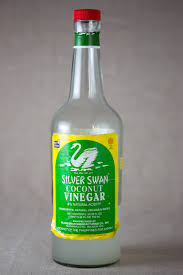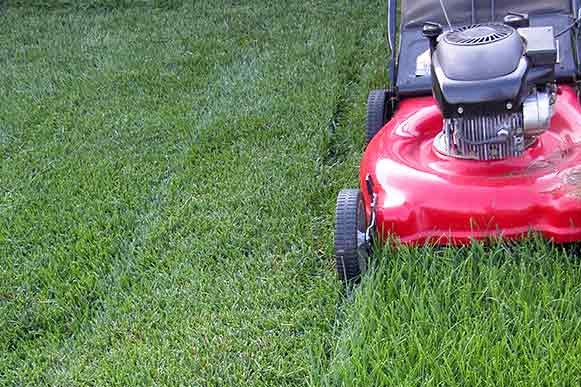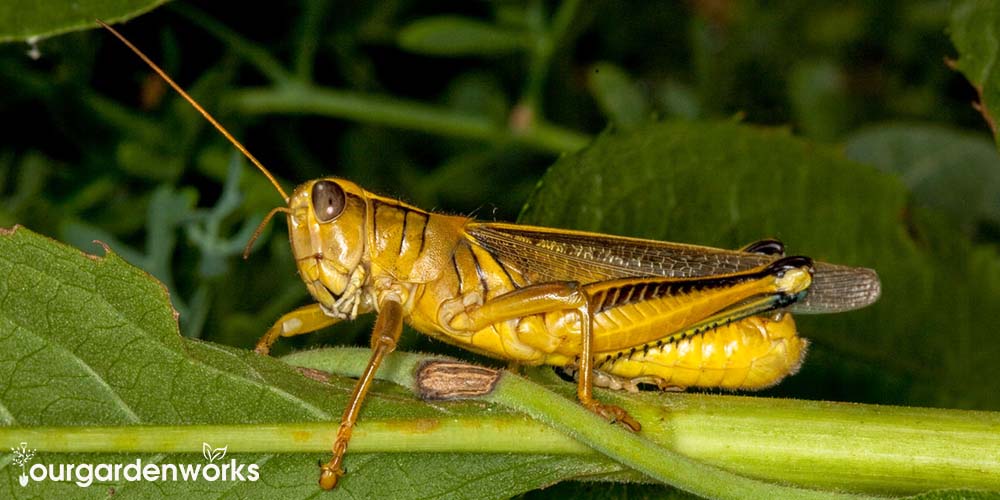Grasshoppers are plant-eating insects with two powerful hind legs that allow them to hop or leap from one plant to another. There are few variants of the species but most generally live near the soil.
Depending on the species, they can have varying colors from the common green to rainbow-colored. They feed on both plants and other insects, as well. As fascinating as these little critters are, they can become a gardener’s horror story and a farmer’s nightmare.
Much like their cousins the locusts, grasshoppers become especially problematic when they invade in swarms and create huge devastation to your garden or farmland.
The nymphs or newly hatched and wingless grasshoppers tend to stay in the same area where they feed and hatch their young.

Soon after, they go through molting and grow their wings. They then finally move on to other areas in search of their next meal.
So how do you kill or prevent them from invading your garden?
The answer to that is something that you can easily find in your kitchen.
Take out your bottle of vinegar and let us find out how to easily get rid of grasshoppers with vinegar.
Why Is Vinegar Effective Against Grasshoppers?

Sure, there are plenty of insecticides out in the market. Although chemical insecticides may be easy to use and can quickly solve a grasshopper infestation, using it is not exactly safe for you, your family, and your pets.
So to protect your loved ones from harmful chemicals, the best thing to do would be to use natural options to stop grasshoppers from eating your plants. One thing you can use to stop them naturally would be using vinegar. It acts as a great bait that can attract grasshoppers.
Vinegar is an acidic fluid that is mainly used for cooking and as a non-toxic and natural cleaning solution for its chemical properties. Additionally, according to studies, the acetic acid present in the vinegar prevents the grasshopper from molting.
The average lifespan of a grasshopper is one year. In that year, it goes through molting five to six times in its life.
It is the stage where the grasshopper sheds its exoskeleton to grow. When it cannot molt successfully, what happens is that it refuses to eat. This will eventually kill the grasshopper off earlier.
Furthermore, vinegar with a sweeter and almost fruity tone is generally attractive to most pests. The apple cider vinegar in particular has a sweet scent to it that attracts many pests like grasshoppers.
How To Repel Grasshoppers With Vinegar In House
There are generally two ways that you can use vinegar to stop grasshoppers from taking over your garden or farm.
The first method you can do is to use vinegar as a grasshopper trap and the second one is to use it as a contact spray.
Here is how to get rid of grasshoppers with vinegar easily:

Recommended item: – 30% Pure Vinegar for Garden
Vinegar Solution For Grasshopper Traps
This method is an effective measure to control the population of grasshoppers in your garden with practically no hassle at all.
Here’s what you will need:

- Apple Cider vinegar (Any vinegar will do but apple cider is the best choice because of its scent)
- Plastic bag or bowl
- Canola oil or any type of seed oil
Step 1:
The first thing that you should do is to fill the plastic or bowl with vinegar. Just remember that your chosen container should be deep enough to trap the grasshopper. You can use any type of container for the trap.
It does not really matter whether it’s glass, plastic, or something else. As long as it is smooth enough that the grasshopper can’t climb out and it’s good.
You should also remember to leave enough space so the grasshopper will not be able to jump out of the solution because it will take some time to kill them off and will not die immediately.
Step 2:
The next thing is to mix in a tablespoon of canola oil. Grasshoppers have strong hind legs and can be troublesome. Adding oil to the solution will make their wings and legs heavier. This will render them the inability to jump or fly out from your chosen container.
What’s more, oil blocks the spiracle or the pores where the insects breathe through which results in suffocation. Additionally, seed oil interferes with the insect’s metabolism.
So, make sure to stir the solution well. Note that these insects eat half of their weight and can even eat as much as a full-grown cow. So adding more weight to their bodies will stop them from getting out.
Step 3:
After you have finished mixing, place your chosen container in an open space in the garden and leave it for a few hours. It would be more efficient to place multiple traps in different spots where grasshoppers will most likely stay.
Lower areas where the grass is abundant is an excellent spot to place the traps on.
Step 4:
The last step is to wait and test your patience.
If your traps are already filled with grasshoppers, pick out the dead ones and dispose of them or you can leave them out on the ground as bird feed.
Furthermore, you can reuse the mixture a few more times until it evaporates or when it becomes too dirty.
Vinegar Solution for Grasshopper Repellent Spray

Spraying is a convenient solution when you want to repel grasshoppers immediately. To make the solution, here are the things that you will need to easily get rid of grasshoppers with vinegar:
- White or Apple Cider vinegar
- Dish soap
- Handheld spray
- Water
Step 1:
The first thing that you should do is to pour in one part vinegar and three parts water into the sprayer and then stir.
The vinegar will act as a bait to attract the grasshopper and will act as a molting blocker as well.
Step 2:
The next step is to add in one part of your chosen dish soap. Soaps have been used to stop insect infestation for more than two centuries now.
Still, there are little findings as to why it effectively repels and kills off insects.
However, some studies have suggested that soap disrupts the cell membranes of the insects which eventually harms or kills them off. Adding this to your mixture will make the solution potentially dangerous to soft-bodied insects like grasshoppers if exposed to a lot.
Plus, it also stops them from escaping or flying away.
Step 3:
The third step is to spray the vinegar and soap mixture on your precious botanicals. Be sure to place focus on the leaves and stems because these are the favorite snacks of these green critters.
It would also be great to spray the solution early in the morning. As with how any insect repellent works, it is best to spray during the period when your target insect is most active.
Although the insects hunt at night, Grasshoppers are also quite active during day time.
They also do not have nests and can migrate in search of food. So it is best to spray onto the leaves when they are active and feeding.
Furthermore, plants absorb a lot of water in the morning, typically between 3 to 8 A.M, so it will absorb more of the solution.
Step 4:
If you ever find a grasshopper, you can spray the solution onto it directly. Make sure to do it so that the insects are thoroughly drenched in the solution.
This will not only stop it from flying but also, take in more of that mixture.
Step 5:
Remember that soap can be toxic to plants, so avoid spraying every other hour. You can safely repeat the process and spray every two days or until you find that the population of the grasshoppers has considerably lowered.
If you have an insecticidal soap available, that would also make this solution more quick-acting.
Other Tips and Tricks To Get Get Rid of Grasshoppers in House
If you have the time, you can hand-pick the grasshoppers in your garden. This will effectively stop them from eating your plants.
You can also consider getting waterproof plant covers for your botanicals that are susceptible to grasshopper infestation.
Although these insects might not be picky eaters, however, they do have their favorites such as grass-type plants like:

- Alfalfa: It is a perennial plant that flowers and are an important forage crop that can be used as hay and many more.
- Corn: It is a cereal grain that can be eaten by humans and livestock. Plus, it can also be processed for chemicals for biofuel among others.
- Wheat: This plant is one of the most commonly eaten cereal and can be used for ingredients like pasta and bread.
- Barley: It is used in both beverages and food, this grain can be grown in moderate temperatures.
- Clover: Also known as trefoil, this common potted plant is part of the pea family and has over 300 species. It can be planted both indoors and outdoors.
- Cotton: It is a seed fiber plant where soft fiber grows around the cottonseed in a somewhat protective cover and grows best in cool temperatures

Furthermore, grasshoppers hate the smell of garlic, onion, and pepper because they find the smell too strong and suffocating. You can add in the juice from chopped garlic, onion, or pepper by placing it in cheesecloth and squeezing the juice out. After that, you can stir it into your vinegar solution.
Another trick that will lessen or even stop the growing grasshopper infestation in your garden is to raise chickens or add more bird feeders.

Birds are the natural predators of grasshoppers and other annoying garden pests. They will definitely love to hunt the annoying critters for you.

Notice that grasshoppers are attracted to fields of overgrown grass and undisturbed land. This is because there is an abundance of food. They also find fields and sands unattractive spots for egg-laying. This is because there is nothing for their hatchlings to feed on.
So if you want to protect your vulnerable crops, cut down the grass around it.

Moreover, it would also repel them if you till the land during their nesting time in summer which will discourage female grasshoppers from laying eggs in that area.
An additional countermeasure for the growing annoyance of grasshoppers is to grow naturally grasshopper repellent plants around your garden. Not only are the plants effective but they are beautiful to look at, too.
These plants are:
- Moss Rose: You can grow them in the shady part of your garden. They will only grow about 6 to 12 inches in height.
- Juniper: It is a part of the cypress plant family. It can easily deter and even kill grasshoppers. You can choose to plant it yourself or buy the oil and dilute it. You can also use its thorny boughs and spread it across your planter to deter grasshoppers from staying.
- Sage: It is a perennial plant that can be grown in pots, both indoors and outdoors. The oils made from this can naturally repel several insects including grasshoppers. Place them in a spray with the vinegar solution. You can choose to burn dried sage or spray a diluted mixture onto the critter directly.
Final Thoughts
Though it may be important to introduce insects to your garden, too much of it can be bad.
So, if you ever spot a growing number of grasshoppers in your garden, make sure to do the necessary steps early on to stop it from becoming a full-blown infestation.
Furthermore, pesticides might bring a quicker solution and can be quite tempting. However, using these as the answer to the growing problem can cause serious harm to not only your garden but your family, as well.
For natural remedies to problems like these, just follow the steps above and our other tips and you can easily stop a grasshopper infestation nightmare from happening.

6 thoughts on “How to Get Rid of Grasshoppers with Vinegar – A Step-by-Step Guide”